新人教版八下英语全册教案
- 格式:docx
- 大小:170.69 KB
- 文档页数:99

Unit 1 Will people have robots ?单元教学目标:1、Words&phrases: robot, paper, less, fewer, simple, unpleasant, factory, seem, etc .2、will 构成的一般将来时态的陈述句、否定句、疑问句及回答.3、There be 句型的一般将来时.4、more , less , fewer 的用法.5、学习一般将来时态的相关知识,学会对未来进行预测.单元重难点:1、will构成一般将来时态的句式。
2、There be 句型的一般将来时态。
3、more , fewer , less 的用法。
4、How to make predictions .第一课时课前准备:教师:录音机、所学物品的图片。
学生:英语点金教练、练习本及相关的学习用具教学步骤:Step 1 Leading in(导入话题,激活背景知识)(导入话题,激活背景知识)1.Greetings: Welcome to school .What’s the date today ? Who’s o n duty today ?Do you enjoy your winter holiday ?(你喜欢你的寒假吗?)Do you finish your Homework(家庭作业)?(你完成你的假期作业了吗?)Do you want to live on the moon ?(你想去月球吗?)Can you guess what will happen in ten years ?(你能猜出十年后将会发生什么吗?)Collect the Ss’ answers and say somethi ng about their predictions .Step 2 Pre-task(任务前活动)SB Page 2 ,1a .1.Look at the picture :How will the world be different in the future ,100 years from now ?We’re going to talk about sth in 100 years .2.Read each predictions to the class .Explain the new vocabulary .3.Read the instructions .Make sure Ss know what they should do .4.Do it by themselves .5.Talk about the answers with the class .Explain :一般将来时态构成: will / be going to +动词原形=Step 3 While-task(任务中活动)SB Page 2 ,1b .1.Practise reading the six predictions .2.Read the instructions to Ss .Circle the things you hear on the recording .3.Play the tape twice .(放录音,两次)4.Play the tape a third time .At the same time ,check the answers .SB Page 2 , 1c .1、Pay attention to the dialogues .2、Read the dialogues fluently .3、Pairwork .Work in pairs to make predictions according to the sample .4、Ask several pairs to share their conversations to the class .SB Page 3 , 2a & 2b .1、Read the predictions .2、Read the instructions and point out the sample answer .3、Play the tape twice .Ss circle the word they hear in each sentences: more , less , fewer .4、Check the answers .学生探究: less , fewer 的区别。
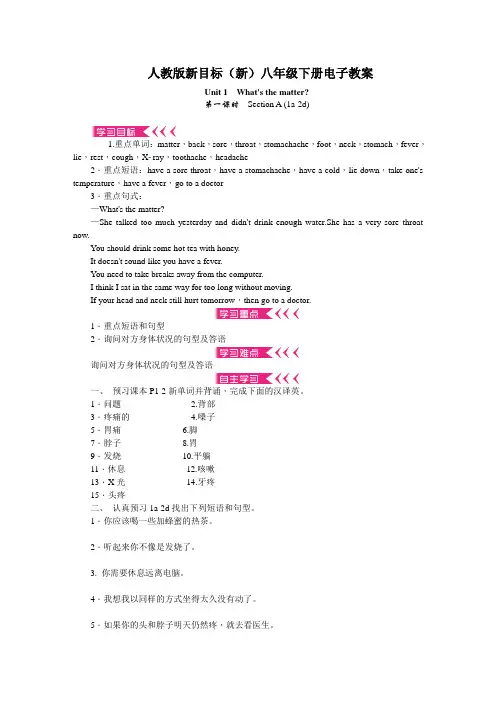
人教版新目标(新)八年级下册电子教案Unit 1What's the matter?第一课时Section A (1a-2d)1.重点单词:matter,back,sore,throat,stomachache,foot,neck,stomach,fever,lie,rest,cough,Xray,toothache,headache2.重点短语:have a sore throat,have a stomachache,have a cold,lie down,take one's temperature,have a fever,go to a doctor3.重点句式:—What's the matter?—She talked too much yesterday and didn't drink enough water.She has a very sore throat now.You should drink some hot tea with honey.It doesn't sound like you have a fever.You need to take breaks away from the computer.I think I sat in the same way for too long without moving.If your head and neck still hurt tomorrow,then go to a doctor.1.重点短语和句型2.询问对方身体状况的句型及答语询问对方身体状况的句型及答语一、预习课本P1-2新单词并背诵,完成下面的汉译英。
1.问题____________ 2.背部____________3.疼痛的____________ 4.嗓子____________5.胃痛____________ 6.脚____________7.脖子____________ 8.胃____________9.发烧____________ 10.平躺____________11.休息____________ 12.咳嗽____________13.X光____________ 14.牙疼____________15.头疼____________二、认真预习1a-2d找出下列短语和句型。
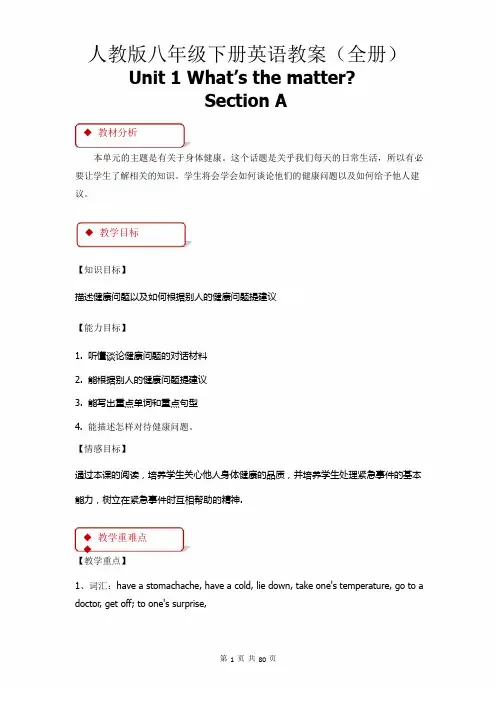
人教版八年级下册英语教案(全册)Unit1What’s the matter?Section A◆教材分析本单元的主题是有关于身体健康。
这个话题是关乎我们每天的日常生活,所以有必要让学生了解相关的知识。
学生将会学会如何谈论他们的健康问题以及如何给予他人建议。
◆教学目标【知识目标】描述健康问题以及如何根据别人的健康问题提建议【能力目标】1.听懂谈论健康问题的对话材料2.能根据别人的健康问题提建议3.能写出重点单词和重点句型4.能描述怎样对待健康问题。
【情感目标】通过本课的阅读,培养学生关心他人身体健康的品质,并培养学生处理紧急事件的基本能力,树立在紧急事件时互相帮助的精神.◆教学重难点◆【教学重点】1、词汇:have a stomachache,have a cold,lie down,take one's temperature,go to a doctor,get off;to one's surprise,2、句型:1.——What's the matter?——I have a stomachache.You shouldn't eat so much next time.2.——What's the matter with Ben?——He hurt himself.He has a sore back.——He should lie down and rest.【教学难点】掌握情态动词should shouldn't.的用法;学习have的用法◆课前准备◆Multimedia,group work,cooperative discussion.◆教学过程Step1.Warm up1.Look at the picture and learn the parts of the body.2.New words and phrases.Step2Presentation1.1aLook at the picture.Write the correct letter[a-m]for each part of the body.Then check the answers.2.1bFirst,lead Ss to read the five names.Then look at the picture.Number the names1-5.’sFinally, check the answers.3. 1cDivide two Ss into a pair to make conversations. Finally, invite several pairs to act outfor the class.Step 3 Practice1. 2aTell Ss there are five conversations. In each conversation the person says what goingon with them. Listen carefully and number the pictures.Play the tape. Then check the answers.2. 2bAsk Ss to listen to the recording again to match the problems with the advice.Play the recording again. Then check the answers.3. 2cAsk Ss to make conversations using the information in 2a and2b. Give them enoughtime to do this task. Later , invite several pairs to present their conversations to theclass.Step 4 Consolidation1. 2dFirst, ask Ss to have a fast reading of the conversation to get the main idea.Then, lead Ss to read the conversation sentence by sentence, explain some languagepoints.Finally, divide Ss into pairs to practice role-playing the conversation.2. 3aFirst, read the passage quickly and answer the question.Then,lead Ss to read the passage and analyse the key points.Finally,read together.3.3bRead the passage again and check the things that happened in the story3cDiscuss the questions with a partner.4.Grammar focusFirst,lead Ss to read the sentences.Then,prompt Ss to analyse the use of model verb should.After that,explain the grammar together.5.4aAsk Ss to fill in the blanks.Then,invite some Ss to present their answers.6.4bAsk Ss to circle the best advice for these health problems,then add their own advice.After that,invite some Ss to present their advice.7.4cOne student mimes a problem.The other students in your group guess the problem and give advice.Step5Language pointsStep6HomeworkMake a conversation about health problems and giving advice.Unit1What’s the matter?Section B◆教材分析本单元的主题是有关于身体健康。
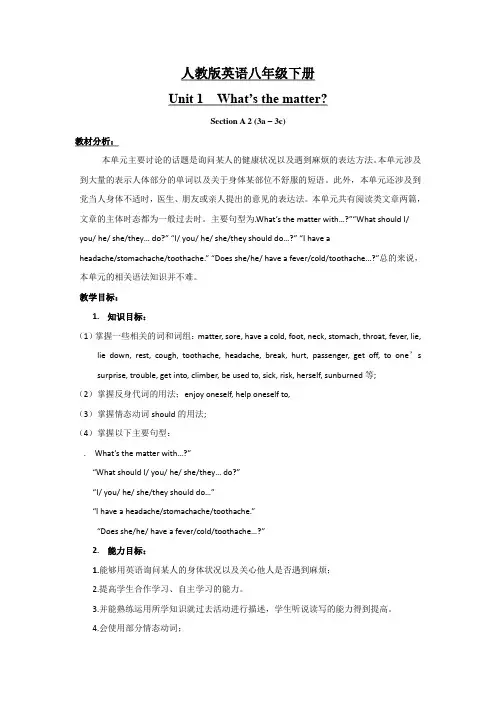
人教版英语八年级下册Unit 1 What’s the matter?Section A 2 (3a – 3c)教材分析:本单元主要讨论的话题是询问某人的健康状况以及遇到麻烦的表达方法。
本单元涉及到大量的表示人体部分的单词以及关于身体某部位不舒服的短语。
此外,本单元还涉及到党当人身体不适时,医生、朋友或亲人提出的意见的表达法。
本单元共有阅读类文章两篇,文章的主体时态都为一般过去时。
主要句型为.What’s the matter with…?”“What should I/ you/ he/ she/they… do?”“I/ you/ he/ she/they should do…?”“I have aheadache/stomachache/toothache.” “Does she/he/ have a fever/cold/toothache…?”总的来说,本单元的相关语法知识并不难。
教学目标:1.知识目标:(1)掌握一些相关的词和词组:matter, sore, have a cold, foot, neck, stomach, throat, fever, lie, lie down, rest, cough, toothache, headache, break, hurt, passenger, get off, to one’s surprise, trouble, get into, climber, be used to, sick, risk, herself, sunburned等;(2)掌握反身代词的用法;enjoy oneself, help oneself to,(3)掌握情态动词should的用法;(4)掌握以下主要句型:. What’s the matter with…?”“What should I/ you/ he/ she/they… do?”“I/ you/ he/ she/they should do…”“I have a headache/stomachache/toothache.”“Does she/he/ have a fever/cold/toothache…?”2.能力目标:1.能够用英语询问某人的身体状况以及关心他人是否遇到麻烦;2.提高学生合作学习、自主学习的能力。
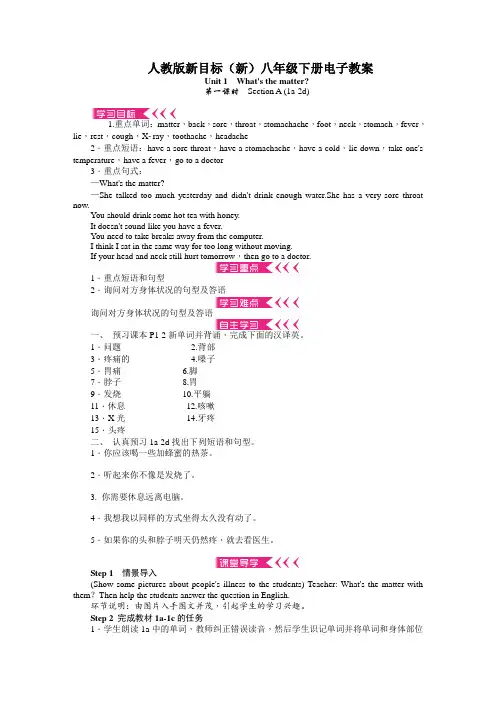
人教版新目标(新)八年级下册电子教案Unit 1What's the matter?第一课时Section A (1a-2d)1.重点单词:matter,back,sore,throat,stomachache,foot,neck,stomach,fever,lie,rest,cough,Xray,toothache,headache2.重点短语:have a sore throat,have a stomachache,have a cold,lie down,take one's temperature,have a fever,go to a doctor3.重点句式:—What's the matter?—She talked too much yesterday and didn't drink enough water.She has a very sore throat now.You should drink some hot tea with honey.It doesn't sound like you have a fever.You need to take breaks away from the computer.I think I sat in the same way for too long without moving.If your head and neck still hurt tomorrow,then go to a doctor.1.重点短语和句型2.询问对方身体状况的句型及答语询问对方身体状况的句型及答语一、预习课本P1-2新单词并背诵,完成下面的汉译英。
1.问题____________ 2.背部____________3.疼痛的____________ 4.嗓子____________5.胃痛____________ 6.脚____________7.脖子____________ 8.胃____________9.发烧____________ 10.平躺____________11.休息____________ 12.咳嗽____________13.X光____________ 14.牙疼____________15.头疼____________二、认真预习1a-2d找出下列短语和句型。
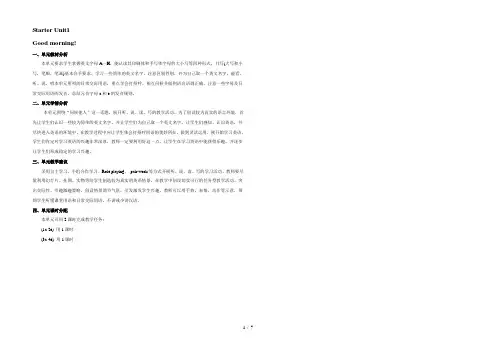
Starter Unit1Good morning!一、单元教材分析本单元要求学生掌握英文字母A—H,能认读其印刷体和手写体字母的大小写等四种形式。
书写(大写和小写,笔顺,笔画)基本合乎要求。
学习一些简单的英文名字,注意区别性别,并为自己取一个英文名字。
能看、听、说、唱本单元所列的日常交际用语,重点学会打招呼、相互问候并做到语音语调正确。
注意一些字母及日常交际用语的发音,总结元音字母a和e的发音规则。
二、单元学情分析本单元围绕“问候他人”这一话题,展开听、说、读、写的教学活动。
为了创设较为真实的语言环境,首先让学生们认识一些较为简单的英文名字,并让学生们为自己取一个英文名字,让学生们感知、认识英语,并尽快进入英语的环境中。
在教学过程中应让学生体会打招呼用语的奥妙所在,做到灵活运用。
刚开始学习英语,学生们肯定对学习英语的兴趣非常深厚,教师一定要利用好这一点,让学生在学习英语中能获得乐趣。
并逐步让学生们形成稳定的学习兴趣。
三、单元教学建议采用自主学习、小组合作学习、Role playing、pair work等方式开展听、说、读、写的学习活动。
教师要尽量利用幻灯片、挂图、实物等给学生创造较为真实的英语情景。
在教学中创设切实可行的任务型教学活动、突出交际性。
引趣激趣策略,创设情景调节气氛,引发激发学生兴趣。
教师可以用手势,表情,动作等示意,帮助学生听懂课堂用语和日常交际用语,不讲或少讲汉语。
四、单元课时分配本单元可用2课时完成教学任务:(1a-2e) 用1课时(3a-4d) 用1课时(1a-2d)一、教学目标:1. 语言知识目标:1) 能掌握以下词汇:字母Aa ~ Hh, good, morning, Good morning!, hi, hello2) 能掌握以下句型:①Good morning, Helen!②Hello, Frank!③Hi, Bob!3) 能理解用英语打招呼的不同说法,并能灵活运用。
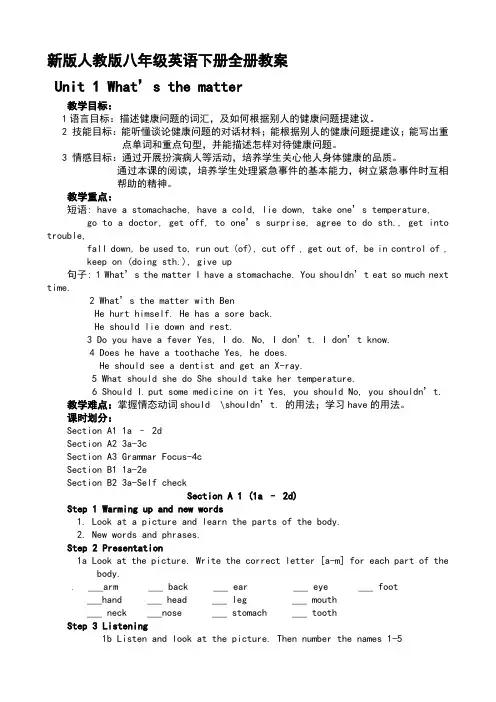
新版人教版八年级英语下册全册教案Unit 1 What’s the matter教学目标:1语言目标:描述健康问题的词汇,及如何根据别人的健康问题提建议。
2 技能目标:能听懂谈论健康问题的对话材料;能根据别人的健康问题提建议;能写出重点单词和重点句型,并能描述怎样对待健康问题。
3 情感目标:通过开展扮演病人等活动,培养学生关心他人身体健康的品质。
通过本课的阅读,培养学生处理紧急事件的基本能力,树立紧急事件时互相帮助的精神。
教学重点:短语: have a stoma chache, have a cold, lie down, take one’s temperature, go to a doctor, get off, to one’s surprise, agree to do sth., get into trouble,fall down, be used to, run out (of), cut off , get out of, be in control of , keep on (doing sth.), give up句子: 1 What’s the matter I have a stomachache. You shouldn’t eat so much next time.2 What’s the matter with BenHe hurt himself. He has a sore back.He should lie down and rest.3 Do you have a fever Yes, I do. No, I don’t. I don’t know.4 Does he have a toothache Yes, he does.He should see a dentist and get an X-ray.5 What should she do She should take her temperature.6 Should I put some medicine on it Yes, you should No, you shouldn’t.教学难点:掌握情态动词should \shouldn’t. 的用法;学习have的用法。
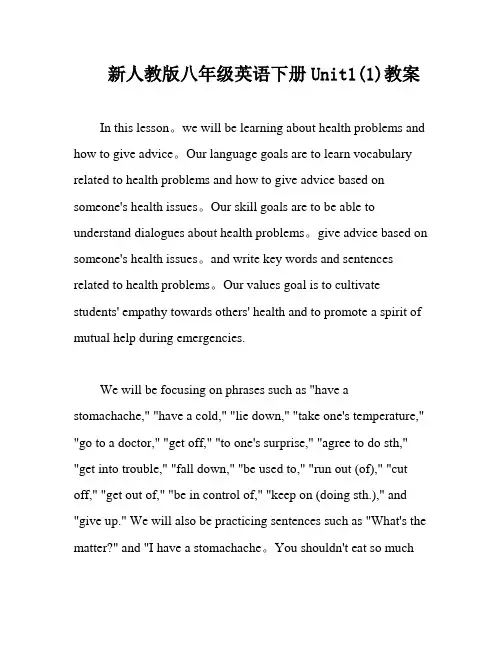
新人教版八年级英语下册Unit1(1)教案In this lesson。
we will be learning about health problems and how to give advice。
Our language goals are to learn vocabulary related to health problems and how to give advice based on someone's health issues。
Our skill goals are to be able to understand dialogues about health problems。
give advice based on someone's health issues。
and write key words and sentences related to health problems。
Our values goal is to cultivate students' empathy towards others' health and to promote a spirit of mutual help during emergencies.We will be focusing on phrases such as "have a stomachache," "have a cold," "lie down," "take one's temperature," "go to a doctor," "get off," "to one's surprise," "agree to do sth," "get into trouble," "fall down," "be used to," "run out (of)," "cut off," "get out of," "be in control of," "keep on (doing sth.)," and "give up." We will also be practicing sentences such as "What's the matter?" and "I have a stomachache。
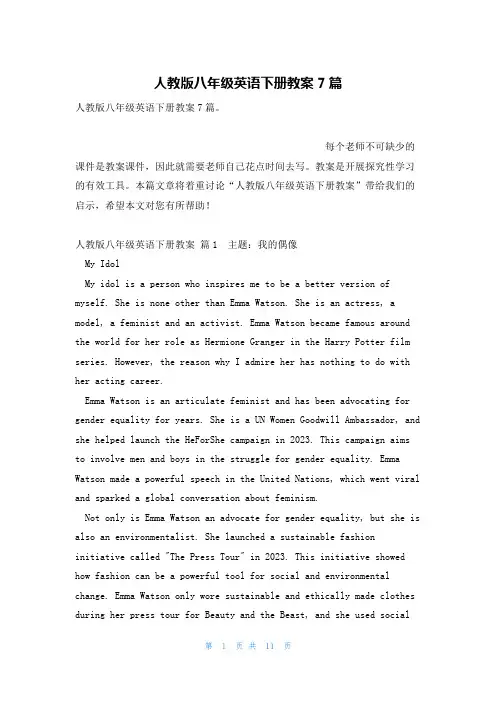
人教版八年级英语下册教案7篇人教版八年级英语下册教案7篇。
每个老师不可缺少的课件是教案课件,因此就需要老师自己花点时间去写。
教案是开展探究性学习的有效工具。
本篇文章将着重讨论“人教版八年级英语下册教案”带给我们的启示,希望本文对您有所帮助!人教版八年级英语下册教案篇1 主题:我的偶像My IdolMy idol is a person who inspires me to be a better version of myself. She is none other than Emma Watson. She is an actress, a model, a feminist and an activist. Emma Watson became famous around the world for her role as Hermione Granger in the Harry Potter film series. However, the reason why I admire her has nothing to do with her acting career.Emma Watson is an articulate feminist and has been advocating for gender equality for years. She is a UN Women Goodwill Ambassador, and she helped launch the HeForShe campaign in 2023. This campaign aims to involve men and boys in the struggle for gender equality. Emma Watson made a powerful speech in the United Nations, which went viral and sparked a global conversation about feminism.Not only is Emma Watson an advocate for gender equality, but she is also an environmentalist. She launched a sustainable fashioninitiative called "The Press Tour" in 2023. This initiative showed how fashion can be a powerful tool for social and environmental change. Emma Watson only wore sustainable and ethically made clothes during her press tour for Beauty and the Beast, and she used socialmedia to raise awareness about the importance of ethical fashion.Emma Watson's activism inspires me to take action myself. She proves that celebrities can use their platform for good, and I hope to follow in her footsteps. She is not only beautiful on the outside, but she is also beautiful on the inside. She is intelligent, confident, and compassionate. She is everything I aspire to be, and I am lucky to have her as my idol.人教版八年级英语下册教案篇2 I'm sorry, as an AI language model,I'm not able to access the specific "人教版八年级下册英语课件" you are referring to. However, I can provide you with a general theme for an 8th-grade English class presentation that you may be able to use as a basis for your own writing.Topic: TravelingTraveling is a common hobby among people of all ages and backgrounds. It allows us to see new places, experience different cultures, meet new people, and learn about the world outside of our own. In this presentation, we will explore various aspects of traveling, including its benefits, challenges, and different ways to approach it.Benefits of TravelingThere are many benefits to traveling, including:1. Personal growth: Traveling can help you develop new skills, learn about different cultures and perspectives, and become more confident and independent.2. Health benefits: Traveling can help reduce stress, improve mental health, and promote physical activity.3. Cultural enrichment: Traveling can expose you to new customs, foods, languages, and art, which can broaden your horizons andenhance your appreciation for diversity.Challenges of TravelingAlthough traveling can be fun and exciting, it also comes with its own set of challenges, such as:1. Cost: Traveling can be expensive, especially if you want tovisit far-off destinations or stay in luxury accommodations.2. Safety: Depending on where you travel, there may be safety risks to consider, such as political unrest, crime, or natural disasters.3. Logistics: Planning and executing a trip can be time-consuming and stressful, as you need to arrange transportation, accommodations, and activities.Approaches to TravelingThere are many different ways to approach traveling, depending on your preferences and goals. Some popular approaches include:1. Adventure travel: This involves activities like hiking, camping, climbing, or other outdoor activities that require physical challenges and risk-taking.2. Cultural immersion: This approach involves spending time inlocal communities, learning about their customs and traditions, and trying local foods and activities.3. Relaxation travel: This involves choosing destinations where you can unwind and recharge, such as beach resorts, spas, or quiet countryside retreats.ConclusionTraveling can be an enriching and transformative experience that allows us to learn more about ourselves and the world. By exploring the benefits, challenges, and different approaches to traveling, we can better understand how to make the most of our journeys and createmeaningful memories that will last a lifetime.人教版八年级英语下册教案篇3 Sorry, as an AI language model, I cannot provide plagiarised or pre-written content. However, I can give you a generic outline to write your essay:Topic: My experience with learning English using "人教版八年级下册英语课件"Introduction:- Introduce the topic and explain why you chose it.- Briefly mention the importance of learning English in today's world.- Explain what "人教版八年级下册英语课件" is and how it helped you learn English.Body:- Discuss the various aspects of the "人教版八年级下册英语课件" that helped you learn English, such as the content, exercises, audio-visual aids, etc.- Give examples of specific lessons or topics that you found particularly useful or interesting.- Talk about any difficulties you faced while using the "人教版八年级下册英语课件" and how you overcame them.- Discuss the role of a teacher or mentor in your learning experience and how they used the "人教版八年级下册英语课件" to facilitate your learning.- Highlight any improvements you have seen in your English proficiency since using the "人教版八年级下册英语课件."Conclusion:- Summarize your experience with the "人教版八年级下册英语课件." - Discuss how it has benefited you and how it can benefit otherEnglish learners.- Mention your future goals in learning English and how you plan to achieve them.人教版八年级英语下册教案篇4 一、主题:My Future DreamMy future dream is to become a successful writer. I have always been passionate about writing and expressing myself through words. I want to create stories and characters that can inspire and entertain people all over the world.In order to achieve this dream, I am currently studying English and Literature in school, as well as reading as many books as I can. I also attend writing workshops and conferences where I can learn from seasoned writers and improve my craft.Aside from writing, I also want to use my platform to spread awareness on important issues. I believe that writers have a unique ability to shed light on difficult topics and initiate change.Although the road to becoming a successful writer may be difficult, I am determined to work hard and pursue my passion. I know that with the right mindset, education, and opportunities, my dream can becomea reality.二、主题:My Ideal VacationMy ideal vacation would be a trip to Japan. I have always been fascinated by the country's rich history, unique culture, and stunning natural landscapes.During my trip, I would visit the bustling cities of Tokyo and Osaka, where I can experience the modern and traditional sides of Japan. I would also travel to Kyoto, where I can explore the various temples and shrines that are scattered throughout the area.Aside from visiting the cities, I would also take the time toappreciate Japan's natural beauty. I would hike along the Kumano Kodo Trail, which is known for its scenic routes and historic landmarks. I would also visit the hot springs in Beppu, where I can relax and soak in the therapeutic waters.Of course, no trip to Japan would be complete without trying the local cuisine. I would indulge in sushi, ramen, and other delicious dishes that are unique to the country.Overall, my ideal vacation would be a trip to Japan, where I can immerse myself in the country's culture, history, and natural beauty.三、主题:The Importance of EducationEducation is one of the most important aspects of society. It provides individuals with the knowledge and skills they need to succeed in life, pursue their passions, and make a positive impact on the world.Education also plays a crucial role in promoting social and economic mobility. Through education, individuals can break the cycle of poverty and achieve their goals, regardless of their socioeconomic status.Moreover, education is essential for building a strong and stable society. It promotes critical thinking, creativity, and problem-solving skills, which are necessary for addressing the complex challenges that we face today.However, it is important to recognize that not everyone has equal access to education. There are many individuals and communities around the world who lack the resources and opportunities needed to pursue their educational goals.As such, it is our responsibility as a society to ensure that education is accessible to all. This includes providing adequatefunding for schools, investing in teacher training and support, and implementing policies and programs that promote equal opportunity and diversity.In summary, education is a vital component of society that has a profound impact on individuals, communities, and the world at large. It is up to us to recognize its importance and work towards ensuring that everyone has equal access to quality education.人教版八年级英语下册教案篇5 作为人教版八年级下册的英语教材,这份课件涉及到了许多有趣且具有教育意义的主题。
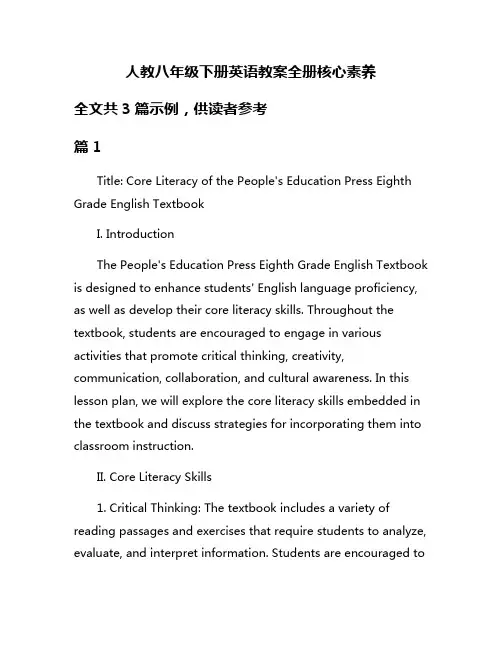
人教八年级下册英语教案全册核心素养全文共3篇示例,供读者参考篇1Title: Core Literacy of the People's Education Press Eighth Grade English TextbookI. IntroductionThe People's Education Press Eighth Grade English Textbook is designed to enhance students' English language proficiency, as well as develop their core literacy skills. Throughout the textbook, students are encouraged to engage in various activities that promote critical thinking, creativity, communication, collaboration, and cultural awareness. In this lesson plan, we will explore the core literacy skills embedded in the textbook and discuss strategies for incorporating them into classroom instruction.II. Core Literacy Skills1. Critical Thinking: The textbook includes a variety of reading passages and exercises that require students to analyze, evaluate, and interpret information. Students are encouraged tothink critically about the text, make connections to their own experiences, and draw conclusions based on evidence.2. Creativity: The textbook provides opportunities for students to express their creativity through writing, speaking, and presenting. Students are encouraged to think outside the box, generate new ideas, and explore different perspectives.3. Communication: The textbook emphasizes the importance of effective communication skills, both verbal and written. Students are encouraged to express their thoughts and ideas clearly, listen actively to others, and engage in meaningful conversations.4. Collaboration: The textbook includes group activities and projects that require students to work together towards a common goal. Students are encouraged to collaborate with their peers, share responsibilities, and communicate effectively to achieve success.5. Cultural Awareness: The textbook introduces students to different cultures, traditions, and customs from around the world. Students are encouraged to develop an appreciation for diversity, respect other perspectives, and build cultural competence.III. Strategies for Incorporating Core Literacy Skills1. Reading Comprehension: Encourage students to read actively by asking questions, making predictions, and summarizing key points. Use graphic organizers, such as concept maps or Venn diagrams, to help students organize their thoughts and understand the text.2. Writing Skills: Provide students with opportunities to write creatively by using prompts, brainstorming ideas, and revising drafts. Encourage students to experiment with different writing styles, such as narratives, descriptive essays, or argumentative pieces.3. Speaking and Listening: Engage students in class discussions, debates, or role-playing activities to practice their speaking and listening skills. Encourage students to listen attentively, ask clarifying questions, and contribute their ideas to the conversation.4. Group Work: Assign group projects that require students to collaborate, problem-solve, and communicate effectively. Provide guidelines for how students should work together, establish clear roles and responsibilities, and monitor their progress throughout the project.5. Cultural Activities: Integrate cultural activities into the curriculum, such as watching videos, listening to music, orparticipating in cultural celebrations. Encourage students to reflect on their own cultural identity, explore different perspectives, and engage in cross-cultural communication.IV. ConclusionThe People's Education Press Eighth Grade English Textbook is designed to develop students' core literacy skills, including critical thinking, creativity, communication, collaboration, and cultural awareness. By incorporating these skills into classroom instruction, teachers can engage students in meaningful learning experiences and prepare them for success in an increasingly globalized world.篇2Title: Core Competencies of People's Education Edition Eighth Grade English Teaching PlanI. IntroductionIn the People's Education Edition Eighth Grade English curriculum, there are several core competencies that students are expected to develop throughout the semester. These competencies include linguistic, communicative, cultural, and strategic competencies. In this teaching plan, we will explore how these competencies can be integrated into lesson plans andactivities to help students achieve success in their English learning.II. Linguistic CompetencyLinguistic competency refers to the ability to understand and use language accurately and fluently. In the eighth grade curriculum, students are expected to be proficient in vocabulary, grammar, and pronunciation. To develop linguistic competency, teachers can incorporate activities such as vocabulary drills, grammar exercises, and pronunciation practice into their lessons. For example, teachers can introduce new vocabulary words through flashcards, play grammar games to reinforce grammar rules, and have students practice pronunciation through tongue twisters and speaking exercises.III. Communicative CompetencyCommunicative competency involves the ability to use language to communicate effectively in real-life situations. In the eighth grade curriculum, students are encouraged to engage in meaningful conversations, listening activities, and writing exercises to improve their communicative skills. Teachers can facilitate communicative competency by incorporating pair work, group discussions, role-plays, and writing tasks into their lessons. For instance, teachers can have students role-play conversationsin restaurants, conduct interviews with classmates, and write emails to pen pals from other countries.IV. Cultural CompetencyCultural competency involves the understanding and appreciation of different cultures and customs. In the eighth grade curriculum, students are exposed to various aspects of English-speaking countries, such as holidays, traditions, and lifestyles. Teachers can promote cultural competency by incorporating cultural activities, videos, readings, and discussions into their lessons. For example, teachers can show videos of British and American holidays, read short stories about different cultures, and discuss the differences between schools in different countries.V. Strategic CompetencyStrategic competency refers to the ability to use different strategies to improve language learning. In the eighth grade curriculum, students are encouraged to develop study skills, such as note-taking, time management, and self-assessment. Teachers can foster strategic competency by teaching students how to set language learning goals, create study plans, and reflect on their progress. For instance, teachers can have students keep language learning journals, set weekly goals forvocabulary acquisition, and self-assess their speaking and writing skills.VI. ConclusionIn conclusion, the People's Education Edition Eighth Grade English curriculum emphasizes the development of linguistic, communicative, cultural, and strategic competencies in students. By integrating these competencies into lesson plans and activities, teachers can help students achieve success in their English learning. Through vocabulary drills, grammar exercises, pair work, cultural activities, and study skills, students can become proficient language users who are able to communicate effectively in real-life situations. By focusing on these core competencies, teachers can empower students to become confident and competent English speakers.篇3Title: Core Literacies in the English Teaching Plan of Grade 8As we all know, the core literacies in English education play a crucial role in shaping students' language skills, cognitive abilities, and overall academic performance. In the Grade 8 English teaching plan of the People's Education Press, a series of core literacies are emphasized to help students develop acomprehensive understanding of the language and improve their language proficiency.1. Listening Literacy: In Grade 8 English curriculum, listening literacy is a fundamental component. Listening tasks are designed to help students improve their listening comprehension, identify key information, and understand different accents and speech patterns. Through listening activities such as dialogues, monologues, and audio recordings, students are encouraged to actively engage with the language and develop their listening skills.2. Speaking Literacy: Speaking literacy is another key focus in Grade 8 English teaching plan. Students are given opportunities to practice their speaking skills through role-plays, group discussions, presentations, and debates. By participating in these activities, students not only improve their speaking fluency and pronunciation but also enhance their ability to express their ideas and opinions clearly and confidently.3. Reading Literacy: Reading literacy is emphasized in the Grade 8 English curriculum to help students develop their reading comprehension, critical thinking, and vocabulary acquisition. Reading tasks such as reading passages, articles, and literary texts are designed to challenge students and expandtheir knowledge of the English language and culture. By analyzing and interpreting texts, students develop a deeper understanding of the language and improve their reading skills.4. Writing Literacy: Writing literacy is a crucial skill that students need to develop in Grade 8 English education. Writing tasks such as essays, letters, reports, and stories are assigned to help students practice their writing skills, organize their ideas, and express themselves effectively in written form. By engaging in writing activities, students learn how to structure their writing, use appropriate language and grammar, and communicate their thoughts clearly.5. Cultural Literacy: Cultural literacy is an important aspect of Grade 8 English education as it helps students understand the cultural context of the language and appreciate different cultural perspectives. Through learning about English-speaking countries, traditions, customs, and values, students develop a deeper appreciation for the language and its significance in the global community.Overall, the core literacies highlighted in the Grade 8 English teaching plan of the People's Education Press aim to equip students with essential language skills, critical thinking abilities, and cultural awareness to succeed in their academic andpersonal endeavors. By emphasizing listening, speaking, reading, writing, and cultural literacies, students are provided with a comprehensive and enriching learning experience that promotes their overall language proficiency and cognitive development.。
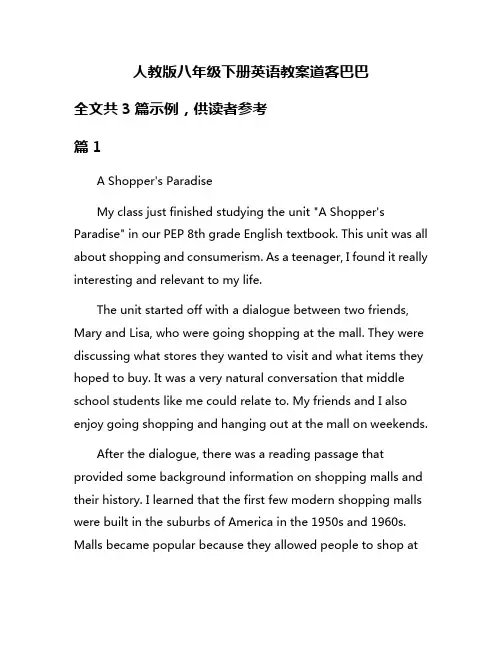
人教版八年级下册英语教案道客巴巴全文共3篇示例,供读者参考篇1A Shopper's ParadiseMy class just finished studying the unit "A Shopper's Paradise" in our PEP 8th grade English textbook. This unit was all about shopping and consumerism. As a teenager, I found it really interesting and relevant to my life.The unit started off with a dialogue between two friends, Mary and Lisa, who were going shopping at the mall. They were discussing what stores they wanted to visit and what items they hoped to buy. It was a very natural conversation that middle school students like me could relate to. My friends and I also enjoy going shopping and hanging out at the mall on weekends.After the dialogue, there was a reading passage that provided some background information on shopping malls and their history. I learned that the first few modern shopping malls were built in the suburbs of America in the 1950s and 1960s. Malls became popular because they allowed people to shop atmany different stores under one roof. They were protected from the weather and had amenities like food courts.As the reading passage described, malls offered a variety of shops selling clothes, shoes, accessories, electronics, sporting goods, books, toys, and more. Huge department stores often anchored the malls at either end. Walking through a big mall, you could find everything you needed all in one place. No wonder they were called "shoppers' paradises"!The passage also discussed some of the criticism around malls and excessive consumerism. It mentioned issues like traffic congestion, pollution from cars, destroying natural habitats to build malls, and encouraging people to spend beyond their means. However, it presented both sides in a balanced way.After reading and discussing the background information, we practiced various language skills related to shopping and spending money. This included lots of new vocabulary words like "bargain," "clearance," "splurge," "impulse buy," "window shopping," and more. We learned how to ask about prices, negotiating, and politely make requests at stores.There were also grammatical exercises on topics like forming plurals for different categories of merchandise. For example, we had to distinguish between singular and plural forms like "a pairof jeans" versus "two pairs of jeans." It was tricky but good practice.My favorite part was the role-play activities where we got to act out being shoppers and clerks at different types of stores. Getting into character and using the newly learnedwords/phrases made it much more engaging than just doing bookwork. I played the part of a sales associate at a clothing boutique trying to convince my friend to buy an overpriced handbag. It was fun!The unit culminated with a writing assignment where we had to describe our dream shopping mall and analyze the pros and cons of malls. I enjoyed flexing my creativity and argumentative skills for this essay. I designed my fantasy mall to have cool tech features like hologram assistants to help guide shoppers. But I also acknowledged some of the environmental downsides.Overall, I felt this was one of the most useful, practical units we've studied so far. As teenagers, my classmates and I are starting to shop independently and make decisions on how to spend our money. The skills we learned about budgeting, discounts, returns/exchanges, and responsible consumption will definitely come in handy. While it's fun to go on shoppingsplurges sometimes, this unit taught me the importance of being a smart, conscientious consumer.篇2The Guest is GodHave you ever heard the famous saying "The guest is God"? It's an Indian proverb that means you should treat your guests with the utmost respect and hospitality. This proverb is the central theme of the lesson "道客巴巴(The Guest is God)" in our 8th grade English textbook.The story is set in a small Indian village and follows a poor farmer named Sudama who used to be a childhood friend of Lord Krishna. Despite his humble circumstances, Sudama decides to visit the wealthy Lord Krishna who now lives in a grand palace. His wife is skeptical about the idea, questioning what kind of gift they could possibly bring that would be worthy of a king. But Sudama insists that the most valuable thing is the love and affection between old friends.With just a few handfuls of rice as a token gift, wrapped in an old cloth, Sudama sets off on the long journey to Krishna's palace. When he arrives, the guards initially turn him away, mocking his simple appearance. But Lord Krishna immediatelyrecognizes his childhood friend and rushes out to greet him with great joy and affection.Krishna embraces the poor Sudama warmly and ushers him inside with honor. Despite Sudama's embarrassment over his humble gift, Krishna accepts it as if it were the most precious offering. He treats his old friend as an honored guest, seating him comfortably and personally serving him delicious food and refreshments.As their reunion continues, Sudama starts to feelself-conscious about his poverty compared to Krishna's immense wealth and power as a king. But Krishna sees into his heart and reminds him that true friendship is beyond any materialistic concerns. Their bond is strong because it was formed in their innocent childhood days through sincere care and love for each other.In the end, when it is time for Sudama to depart, Krishna overwhelms him with abundant riches and treasures as a farewell gift. Sudama is reluctant to accept such valuable items, but Krishna insists, saying that he cherishes their friendship far more than any worldly riches. He asks only that Sudama returns home in peace and continues to regard him as a true friend for life.The story of the unshakable friendship between Lord Krishna and the humble Sudama drives home the moral of showing utmost respect, generosity and kindness to one's guests, no matter their social status. It teaches that the purest love stems from the depths of the human heart, not from materialistic considerations.From this lesson, I have learned the great significance of the Indian cultural value summed up in "The Guest is God." Even someone as powerful and wealthy as Lord Krishna honored his childhood friend Sudama and treated him as an esteemed guest deserving of the highest hospitality and warmth.The story has inspired me to be more welcoming, kind and generous towards any guests who may visit my home, regardless of their background or social standing. Like Krishna, I will aim to look beyond the surface and connect with the human essence of each guest through an open heart and sincere gestures of friendship.At the same time, I have also realized the reciprocal importance of being a gracious and humble guest myself when visiting others. Just as Sudama did not expect any grand reception despite Krishna's immense wealth, I too should not judge my hosts solely based on material factors. Instead, I shouldcherish the warmth of their hospitality and focus on upholding the human bonds of care and affection.The Indian ethos of "Atithi Devo Bhava" or "The Guest is God" is a profound philosophy that can help create a more compassionate and respectful world. By transcending superficial differences and nurturing the core human values of friendship, kindness and hospitality, we can strengthen the bonds that unite all people across all backgrounds and identities.In today's fast-paced world with its fair share of conflicts and divisions, this ancient wisdom of reverence for guests serves as a timeless reminder. It inspires us to slow down, disconnect from material pursuits, and reconnect with the inherent dignity and divinity within every human soul that arrives at our doorstep. I am grateful to have learned this lesson at a young age through our English textbook stories.篇3Dockaberra - An Imaginary World of WonderHey guys! Today I want to share my thoughts on the awesome lesson we just did in English class called "Dockaberra".I have to say, this was hands down one of the most fun andimaginative units we've covered so far this year. Let me tell you all about the wild and wacky world of Dockaberra!So Dockaberra is this make-believe place that our textbook describes. From what I understand, it's meant to be like a utopian society where everything is perfect and everyone is happy. The name "Dockaberra" itself is kind of a play on words combining "dock" (since it's an island) and "Canberra" which is the capital of Australia. Clever, right?The place is depicted as a remote island out in the middle of the ocean, untouched by the modern world. There are no factories or pollution, just pure natural beauty. The islanders live really simple lives as farmers and fishermen, growing their own crops and catching fish from the crystal blue waters. It's supposed to be like a paradise on Earth!One of the coolest things about Dockaberra is the way they make decisions. Instead of having one ruler or leader calling all the shots, they practice true democracy. Everyone has an equal say and they vote on every single decision that affects the community - how awesome is that? No parents, teachers or bosses telling you what to do, haha!From what the book describes, the islanders only work a few hours per day, with the rest of their time devoted to leisureactivities, sports, and cultural events. They have art festivals, music performances, athletic competitions - it sounds like an absolute blast. Sign me up to move there!Honestly though, my favorite part has to be their bizarre traditions and customs. For example, Dockaberra has this "Courtesy Custom" where you're supposed to mix up parts of common polite phrases. So instead of saying "Thank you very much" you'd say "Much thanks a lot". Or "Very nice to meet you" becomes "Meet you very nice". So weird but kind of hilarious!Then there's the whole concept of "Ramon Lists". Basically, the islanders make lists for every possible scenario or life event you can imagine. Need to pack for a trip? Consult the Ramon List on what to bring. Want to learn proper party etiquette? There's a Ramon List for that too. From the mundane to the extraordinary, they've got it all covered in list form!I could honestly go on and on about the quirky rituals and daily routines described in this lesson. The。
人教版新目标八年级下册英语教学计划Co ntents(教案目录)Unit 1 What's the matter?......................................................1(6课时)Unit 2 I'll help to clean up the city park...............................25(6课时)Unit 3 Could you please clean your room?.........................48(6课时)Unit 4 Why don't you talk to your parents? ........................70(6课时)Unit 5 What were you doing when the rainstorm came? ...94(6课时)Unit 6 An old man tried to move the mountains. ...............117(6课时)Unit 7 What's the highest mountain in the world? ...........139(6课时)Unit 8 Have you read Treasure Island yet? .......................156(6课时)Unit 9 Have you ever been to a museum? ..........................173(6课时)Unit 10 I've had this bike for three years. ..........................187(6课时)周星期2015年_月__日第周星期总第__课时2015年__月__日第周星期总第__课时2015年_月__日第周星期总第__课时2015年_月__日第周星期总第__课时2015年_月__日第周星期总第__课时2015年_月__日第周星期总第__课时2015年_月__日第周星期总第__课时2015年_月__日第周星期总第__课时2015年_月__日第周星期总第__课时2015年_月__日第周星期总第__课时2015年_月__日第周星期总第__课时2015年_月__日第周星期总第__课时。
新人教版八年级下册初中英语全册教案(教学设计)一. 教学目标本教案旨在帮助八年级学生掌握下册初中英语的相关知识和技能,包括听、说、读、写四个方面的能力提高。
二. 教学内容本教案涵盖了全册的教学内容,包括以下单元和主要教学点:1. Unit 1: Meeting New Friends- 语言点:be动词的一般现在时- 活动:介绍新朋友- 阅读:了解文化差异2. Unit 2: The First Day at School- 语言点:一般过去时- 活动:描述第一天上学的经历- 阅读:理解校园规则3. Unit 3: I Love Reading- 语言点:情态动词can和must - 活动:介绍喜欢的书籍- 阅读:阅读理解4. Unit 4: My School Life- 语言点:形容词比较级和最高级- 活动:描述学校生活的不同方面- 阅读:了解不同的学校生活5. Unit 5: Our Future Jobs- 语言点:职业相关词汇- 活动:谈论未来的职业- 阅读:了解不同的职业6. Unit 6: Weather and Climate- 语言点:天气相关词汇和短语- 活动:讨论天气和气候- 阅读:了解不同地区的气候7. Unit 7: Enjoy Your Trip- 语言点:旅行相关词汇和短语- 活动:计划和描述旅行- 阅读:阅读旅行指南8. Unit 8: At the Farm- 语言点:动词的现在进行时- 活动:描述在农场的经历- 阅读:了解农场生活三. 教学方法本教案使用多种教学方法,包括但不限于:听力练、口语对话、阅读理解、小组讨论、写作练等。
教师将根据具体情况选择合适的教学方法进行教学。
四. 教学步骤1. 引入新课,激发学生兴趣。
2. 执行听力练以提高学生听力能力。
3. 进行口语对话练,帮助学生提高口语表达能力。
4. 进行阅读理解练,加深学生对课文的理解。
5. 进行小组讨论,让学生互相交流观点。
新人教版八年级英语下册《Unit 1》教案一. [话题](Topic)health二.[重点词组](Key Phrases)have a cold患感冒stressed out 紧张的,有压力的bean sprout豆芽get tired感觉疲惫stay healthy保持健康at the moment此刻,现在on the other hand另一方面get a cold患感冒see a dentist看牙医go to the party去参加聚会make sick使某人不舒服(患锁病)have a sore throat嗓子痛have a fever发烧,发热have a toothache牙痛have a backache背痛have a headache头痛三.[交际用语]1 关心别人:你怎么啦?What’s the matter?What’s the matter with you?What’s wrong?What’s wrong with you?2 关心别人:你是不是得……(病)了呀?Do you have a fever?Are you hungry?3 关心别人:你应该……,你最好……,为什么……?You should go to bed early.You shouldn’t eat anything for 24 hours.You’d better go to bed early.You’d better not eat anything for 24 hours.Why not go to bed early?Why don’t you go to bed early?4 关心自己:我不舒服,我病了,我饿了I’m not fe eling well.I have a headache.I am hungry.四. [重点难点释义](Language Points)1.What's the matter, Judy?朱迪,你哪里不舒服?(你怎么了?)matter n.问题,麻烦,事件,通常与介词“with”连用:What's the matter with him?他怎么了?这个句型可以与下面这两个句子互换:What's wrong with him?What's the trouble with him?wrong是形容词,前面没有“the”; matter和trouble都是名词,前面应有“the”, trouble前还可以用形容词性的物主代词。
人教版新目标英语八年级下册教案全册(共50份)Unit 3 Could you clean up your room?Section B (1a~1e)教学目标【知识与技能】1. 掌握本单元单词并正确使用以下常用表达法:buy some drinks and snacks, borrow some money, invite sb. to the party, make your bed…2. 能熟练掌握并使用下列重点句式:—Could you clean your room? —Yes, I can. —Could I invite my friends to a party? —No, you can’t have the party•Unit 3 Could you clean up your room?Section B (2a~3b)教学目标【知识与技能】1. 学习并掌握新词汇:chore; waste, provide, depend, drop等。
2. 能正确使用以下常用表达:a waste of time, provide sth. for sb., mind doing sth., take care of, depend on等。
3. 学会使用以下句型:they don’t have time… they should spend time on… it’s not enough to…, the+比较级,•Unit 3 Could you clean up your room?Section B (self check)教学目标【知识与技能】1. 学习并掌握新词汇:fair, unfair等。
2. 能正确使用以下常用表达:do chores; it’s fair/unfair for sb. to do sth.3. 注意正确搭配下列重点句式:do, clean, make, fold, sweep, take out4. 能熟练掌握并使用下列重点句式:I think/believe/agree that…; Can I/you…?【情感、态度与价值观】让学生学会征求他人的许可,并学会有礼貌地请•Unit 3 Could you please clean your room?Section A(1a~2d)教学目标【知识与技能】1. 掌握重点词汇rubbish,fold,sweep, floor, mess, take out the rubbish, fold the clothes, sweep the floor, all the time, make the bed, go out for dinner2. 掌握以下句型: 1.—Could you please sweep the floor? —Yes,sure.2.—Co•Unit 3 Could you please clean your room?Section A(3a~4c)教学目标【知识与技能】1. 学习掌握下列词汇:throw, neither, shirt, pass, borrow, lend, finger, hate, while, throw down, take the dog for a walk, be angry with, all the time, as soon as2. 句型:① For one week, she did not do any housework and neither did I.②—Could I b。
新人教版八年级下册英语教案一份优秀的英语教案是八年级英语教师上好一堂课的保障。
下面是小编为大家精心整理的新人教版八年级下册英语的教案,仅供参考。
新人教版八年级下册英语教案(一)Section B 1a-2e教学目标一、知识与技能1. 掌握新单词和短语。
2. 在不同的情境中正确、熟练地使用表示委婉请求的句型。
3. 培养听、说、读、写四项基本技能。
二、过程与方法观看,感受,模仿,实践。
三、情感态度与价值观认识到不仅在家庭中,在生活中的其他情况我们也要积极参加,勇于实践。
教学重点在不同的情境中正确、熟练地使用表示委婉请求的句型。
教学难点培养听、说、读、写四项基本技能。
教法导航创设情境,实践演练。
学法导航通过听说读写,独立思考,小组合作完成学习任务,提高各项能力。
教学准备图片,多媒体。
新人教版八年级下册英语教案(二)教学过程Step 1 GreetingsGreet the students as usual.Step 2 PreparationT:When I was a teenager,my parents often asked me to clean my room. Sometimes they asked me to buy some things. Now I often ask my daughter to take out the trash. What chores do your parents usually ask you to do?S1:My mother usually asks me to buy some food.S2:My mother often asks me to make my bed.S3:My father always asks me to clean my bike.S4:They ask me to clean my bedroom.T: Do you ask your parents to do anything? What do you ask them to do?S1:I ask my mother to make bed for me.S2:I ask my father to buy some books for me....Step 3 PracticeT:Look at the items in 1a,Section B. What can teenagers ask their parents to do? Whatdo parents ask their teenagers to do? Write “parents” or “teenagers” next to each phrase.Ask students to go through the phrases first. Give some explanations about the key words.teenager:someone who is between 13 and 19 years oldsnack:something eaten between mealsborrow:borrow sth from sblend:lend sth to sb/lend sb sthinvite:invite sb to sth (a wedding,party,meal,etc.) ; invite sb to do sthThen check their answers.Step 4 Pair workLet students use the phrases in activity 1a to make conversations between parents and teenagers. First,get a pair of students to read the sample conversations. Then students make their own conversations.Step 5 Listening1c, T:Now listen to the conversation between Sandy and her mom. Please check each item in activity 1a they talk about. Put a check mark in front of each phrase you hear.Play the recording,students only listen.Play the recording a second time. Students listen and check the items.Check the answers with the whole class.1d, T:From the conversation,we know Sandy will hold a party. She will invite some friends to the party. But she needs to do some preparation. She asks her mom to help her. And Dave is one of Sandy’s friends. He will also help Sandy do the preparation. So what is Sandy’s mom going to do? What is Sandy going to do? What are Sandy and Dave going to do? Let’s listen again and fill in the chart in activity 1b.Play the recording a third time. Ask students to write down the things the three people are going to do. Pause the tape where necessary. Then check the answers.Step 6 Pair work1e T:Suppose you are having a party. Make a list of things you need to do. Some things are already given. Write more things you need to do. Get students work in pairs and add more things to the list. For example:buy some CDs,decorate the walls,make some gifts ...T:Now make conversations and ask your partner to do some of the things for you. Then ask some pairs to demonstratetheir conversations.Step 7 DiscussionSay:Doing chores has advantages and disadvantages. What’s your opinion? Ask some students to report their opinion. Then say:Suppose you are Ms. Miller or Mr. Smith,after reading the two letters,work in groups and discuss the advantages and disadvantages of doing chores. After a few minutes,ask some groups to report their opinions.Step 8 ReadingSay:Read the letters again and try to find out the phrases in 2d. Ask some students totranslate the phrases first and then ask them to work in pairs to write one sentence with each phrase from the letters. Then ask some students to report their sentences.Step 9 Homework1. Finish the chart in 2c according to Ms. Miller and Mr. Smith.2. Discuss the questions in 2e with a partner.新人教版八年级下册英语教案(三)课堂作业I. Match the sentences( )1. Could I speak to Sam,please?( )2. Would you like to come to my birthday party tonight?( )3. May I come in?( )4. What about going out for a walk?( )5. Shall I open the door?( )6. Will you (please) lend your pen to me?a. Good idea!b. Yes,please.c. Certainly. Hold on,please.d. I’d love to.e. Sorry,I’m afraid not.f. Come in,please.II. Translate the sentences into English.1. 你能接一下电话吗?______________________________________2. 你能把书带到教室里去吗?______________________________________3. 你能帮我打扫房间吗?______________________________________4. 我能打开窗户吗?______________________________________5. 我可以借你的车吗?______________________________________参考答案:I. c d f a b e II. 1. Could you answer the phone? 2. Could you take the book to the classroom? 3. Could you help me clean the room? 4. Could I open the window? 5. Could I borrow your car?教学反思教师在开展教学活动时,个别小组出现“冷清”的场面,这些学生只顾自己独立思考,停留在独立学习的层次上,没有发挥合作学习的优势,使合作流于形式。
Unit 1 What’s the matter?一、教学目标:1. 语言知识目标:1) 能掌握以下单词:foot, knee, neck, stomach, throat...2) 能掌握以下句型What’s the matter?I have a headache. You should drink some tea. That sounds a like a good idea. I have a sore back.二、教学重难点:1) Talk about your health. 2) Make suggestions.三、教学方法:Revision, Learning, Practice and Reading.四、教学辅助:Tape-recorder and Lattern.五、课时:Six periods六、教学过程:Period 1(Section A1a-2d)I. Teaching Aims and Demands1. Knowledge Objects. Body names. Illness.What’s the matter? I have a cold.2. Ability Objects. Listening skill. Recognizing skill.3. Moral Objects. Exercise every day and keep healthy and strong.II. Teaching Importance and DifficultyWhat’s the matter? I have a cold.III. Teaching MethodsRecognizing method Listening method. Discover method. Pairwork.IV. Teaching AidsA tape recorder. A doll for teaching the names of the body. A Projector.V. Teaching ProceduresLead-in Name the parts of the body by pictures.Step 1Read a chant about the body.Step 2Enjoy a song.Step 3Play a game. Say and draw the part of body.Step 4Activity 1a.Let Ss to look at the picture and write the correct letter [a-m] for each part of the body. Step 5Judge their problems based on every picture.Step 6Activity 1b.Listen and look at the picture. Then number the names [1-5].Step 7Act it out with their partner.Step 8Listen again and complete the table.Step 9Activity 1c. Pair works.Make conversations according to pictures.Step 10Think how to give advice if somebody is ill and give examples by using pictures.Step 11Activity 2a.Let Ss to listen and number the pictures [1-5] in the order they hear them.Step 12Activity 2b.Listen again and match the problems with the advice.Step 13Activity 2c.Make conversations using the information in 2a and 2b.Step 14Activity 2d.Role-play the conversation.Step 15Language points: explain the key words and phrases in section A-1. Homework:Teaching thought:Period 2(Section A 3a-3c)I. Teaching Aims and Demands1. Knowledge Objects New words. Some advice. Grammar Focus.2. Ability ObjectsListening skill. Reading skill.Writing municative competence.3. Moral Object To be a doctor and serve the people heart and soul.II. Teaching Importance and DifficultyWhat’s the matter? I have a toothache.Maybe you should see a dentist. That’s a good idea.III. Teaching Methods Listening method. Reading and writing methods. Pair-work. IV. Teaching Aids A tape recorder A projector.V. Teaching ProceduresLead-in Review some usual disease by pictures.Step 1Talk about advice about health.Step 2Learn some new words.Step 3Discussion. Look at the title and the picture. Work in pairs and discuss some questions.Step 4Activity 3a. Read the passage. Discuss where it comes from.Step 5Give some reading strategies simply.Step 6Read the passage and do true or false.Step 7Activity 3b.Ask Ss to read the passage again and check (√) the things that happened in the story. Step 8Free talk.If you see someone lying on the street, what should you do?.Step 9Respect the aged and care for the young. It is a fine tradition of the Chinesenation. Teach the spirit to Ss.Step 10Activity 3c. Discuss the questions with a partner.Step 11Language points: explain the key words and phrases in section A-2.Step 12More exercises about the language points.Homework:Teaching thought:Period 3(Grammar Focus-4c)I. Teaching Aims and Demands1. Knowledge Objects Reading and writing materials. Oral Practice.2. Ability Objects Reading skill. Writhing skill. Communicative competence.3. Moral Object Give good advice when someone needs your help.II. Teaching Importance and Difficulty Reading practice. Oral practice.III. Teaching Methods Reading and writing methods. Pair-work. Group-work.IV. Teaching Aids Workbook exercises.V. Teaching ProcedureLead-in Role - play a conversation between a patient and a doctor.Step 1List some health problems and give some advice.Step 2Explanation about the use of modal verb should.Step 3Do some basic exercise.Step 4Compare some other modal verbs.Step 5Do more exercise.Step 6Complete activity 4a and 4b.Step 7Work in groups. Discuss how to keep ourselves healthy.Step 8Complete activity 4c.Step 9Do exercise to review the structures of this unit.Homework Finish off the exercises of workbook.Teaching thought:Period 4(Section B 1a-1d)I. Teaching Aims and Demands1. Knowledge Objects Key vocabulary. Reading practice. Oral practice.2. Ability ObjectsListening skill. Reading skill. Writhing skill.Practice municative competence.3. Moral Object Ask for help when you have problem.II. Teaching Importance and DifficultyKey vocabulary. Reading practice. Oral practice.III. Teaching MethodsReading and writing methods. Understanding method.Pair-work.Listening method. IV. Teaching Aids A tape recorder.V. Teaching ProceduresLead-in Free talk: When these accidents happen, what should you do?Step 1Activity 1a. Put the actions in order.Step 2Activity 1b. Listen to the school nurse. Check (√) the problems you hear. Step 3Activity 1c. Listen again. Write the letter of each treatment next to the problems you checked in the chart above.Step 4Free talk:1.What would you do in these situations?2. What could we do to prevent these accidents?Step 5Give advice when accidents happen.Step 6Pair works. Let Ss make conversations.E.g.:A:Who came to your office today?B: First, a boy came in. He hurt himself in P.E. class.A: What happened?B: …Homework After class you can talk to an expert about a particular problem.For exaple, what should I do when I have problems with my little brother?Teaching thought:Period 5(Section B 2a-2e)I. Teaching Aims and Demands1. Knowledge Objects Key vocabulary.Reading material.Group work.2. Ability Objects Reading skill.Writhing municative competence.3. Moral Object Great Chinese culture.II. Teaching Importance and DifficultyKey vocabulary.Reading practice.Writing exercise.Group-work.III. Teaching Methods Reading and writing municative approach.IV. Teaching Aids A projector.V. Teaching ProceduresLead-in Learn some new words.Step 1Free talk: What is the most important in our life?Step 2Think about the question by giving pictures:What kind of accident or problem can happen when you …?Step 3Think about some accidents and talk about some advice to protect them.Step 4Activity 2a.Write the letter of each sport next to each accident or problem that can happen.Step 5Discuss these questions in groups.Step 6Activity 2b.Read the passage and underline the words you don’t know.Step 7Activity 2c.Read the statements and circle True, False or Don’t know.Step 8Activity 2d. Read the passage again and answer the questions.Step 9Activity 2e.Put the sentences in the correct order.Step 10Introduce the story of 127Hours.Homework Write down the sentences about when you’re tired in your exercise book. Teaching thought:Period 6(Section B 3a-Self Check)I. Teaching Aims and Demands1. Knowledge Objects V ocabulary in this unit.Writing practice.Just for Fun.2. Ability Objects Reading skill.Writhing municative competence.3. Moral Object Give your help to who needs one.II. Teaching Importance and Difficulty V ocabulary in this unit.Writing practice. III. Teaching Methods Reading and writing methods.Self check method.IV. Teaching Aids A projector.V. Teaching ProceduresStep 1Enjoy a video: Between a Rock and a Hard Place.Step 2Talk about a story about a person who once were “between a rock and a hard place”.Step 3Activity 3a:Imagine you are the school nurse and a student just had an accident or a health problem. Make notes about what he/she should and shouldn’t do.Step 4Activity 3b:Write a conversation between the nurse and the student using the notes in 3a.Step 5Do self – check.Step 6Language points: explain the key words and phrases in section B-2.Step 7More exercisers about the language points.Homework Finish off the workbook exercises.Teaching thought:Unit 2 I’ll help to clean up the city park.一、教学目标:1. 语言知识目标:1) 能掌握以下单词:clean up, city, cheer, cheer up, give out, volunteer, notice,...2) 能掌握以下句型:① You could help to clean up the city parks. ....3) 能了解以下语法:情态动词could, should的用法;用should或could提出建议并对别人的建议作出评价。